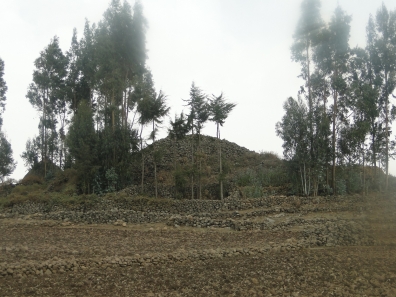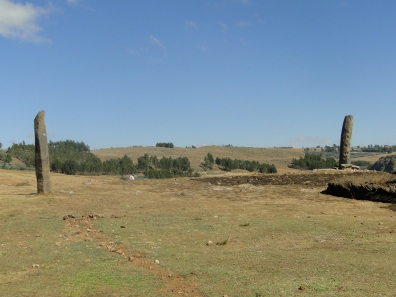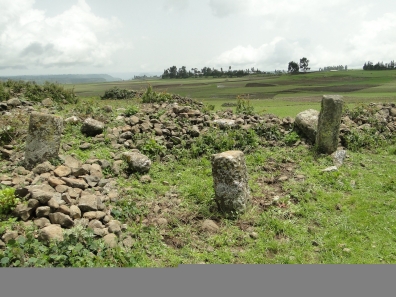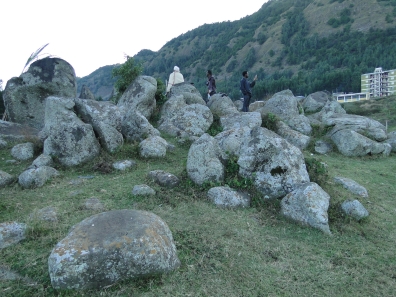-
The Megalithic Monuments of the Shay Culture
En savoir plus...
 The Shay culture got its name after a river called Shay in Menz, Ethiopia, along which several tumuli were located. It is principally characterized by tumuli of different morphological features with stelae and other dry-stone wall structures as well as hypogea. So far, C-14 dates imply that the culture was prevalent from the 10th to 14th centuries (Fauvelle & Poissonnier, 2016). Geographically, it encompasses the central highlands region of Ethiopia that includes areas that lie from Debre Berhan to Dessie towns, which includes historical provinces, such as Tegulet, Menz, Yifat and adjacent areas of south and eastern Wollo. (Alebachew Belay Birru, February 2023)
The Shay culture got its name after a river called Shay in Menz, Ethiopia, along which several tumuli were located. It is principally characterized by tumuli of different morphological features with stelae and other dry-stone wall structures as well as hypogea. So far, C-14 dates imply that the culture was prevalent from the 10th to 14th centuries (Fauvelle & Poissonnier, 2016). Geographically, it encompasses the central highlands region of Ethiopia that includes areas that lie from Debre Berhan to Dessie towns, which includes historical provinces, such as Tegulet, Menz, Yifat and adjacent areas of south and eastern Wollo. (Alebachew Belay Birru, February 2023) -
The Megalithic Monuments of the Shay Culture in history
En savoir plus...
 The topography of the Central Highlands of Ethiopia is characterized by mountainous landscapes with alternating plateaus and gorges. Most of the megalithic sites recorded are positioned on the plateaus. However, there are also sites in the escarpment to the east that lie between the plateau and the Eastern Lowlands, which is connected with the Rift Valley. Data about the prehistory and early history of the Central Highlands of Ethiopia are rare. Despite the relative abundance of historical (mainly hagiographies and chronicles) and archaeological evidence, the medieval past is also far from complete, save for recent works on Christian, Muslim, or traditional-religious sites. Hence, it is still difficult to present ancient historical bases as a prelude in dealing with the medieval…
The topography of the Central Highlands of Ethiopia is characterized by mountainous landscapes with alternating plateaus and gorges. Most of the megalithic sites recorded are positioned on the plateaus. However, there are also sites in the escarpment to the east that lie between the plateau and the Eastern Lowlands, which is connected with the Rift Valley. Data about the prehistory and early history of the Central Highlands of Ethiopia are rare. Despite the relative abundance of historical (mainly hagiographies and chronicles) and archaeological evidence, the medieval past is also far from complete, save for recent works on Christian, Muslim, or traditional-religious sites. Hence, it is still difficult to present ancient historical bases as a prelude in dealing with the medieval… -
The Megalithic Monuments of the Shay Culture in their Landscape
En savoir plus...
 The distribution of megalithic sites on the Central Highlands of Ethiopia follows divergent topographic features. There are cases where these sites are found concentrated along river banks and chains of plateaus. The geographic contrast in the region from the highland to the mid- and lowlands, with clear deviation in typology, is another enduring feature of megalithism in the region. As one moves from the tumuli-dominated highlands of Menz towards Ifat in the east, there continues the tumuli tradition but lesser in quantity, with the gradual appearance of stelae culminating with the sole presence of dressed and decorated stelae in Gadelomeda and Ergotila areas, that are adjacent to the megalithic Islam graveyard sites in the east (Alebachew, 2020b; Alebachew, 2020c). These…
The distribution of megalithic sites on the Central Highlands of Ethiopia follows divergent topographic features. There are cases where these sites are found concentrated along river banks and chains of plateaus. The geographic contrast in the region from the highland to the mid- and lowlands, with clear deviation in typology, is another enduring feature of megalithism in the region. As one moves from the tumuli-dominated highlands of Menz towards Ifat in the east, there continues the tumuli tradition but lesser in quantity, with the gradual appearance of stelae culminating with the sole presence of dressed and decorated stelae in Gadelomeda and Ergotila areas, that are adjacent to the megalithic Islam graveyard sites in the east (Alebachew, 2020b; Alebachew, 2020c). These… -
History of archaeological research on the Megalithic Monuments of the Shay Culture
En savoir plus...
 Some of the megalithic sites in the region, particularly the stelae found in the vicinity of Debre Berhan, were visited and noted by travellers such as a Frenchman Paul Soleillet in 1882 (Soleillet, 1886), and an Italian, Antonio Cecchi, in 1886. A century later, in 1982, French archaeologist Francis Anfray visited the stelae that Soleillet had documented earlier and some other megalithic and medieval sites in the Menz area (Anfray, 1983). In 1986, a team of archaeologists from the Ethiopian Heritage Authority (then Centre for Research and Conservation of the Cultural Heritage of Ethiopia) conducted a quick survey on the stelae field of Gadelomeda (Tekle Hagos, 2000). A French archaeological rescue team led by Bertrand Hirsch visited this same site…
Some of the megalithic sites in the region, particularly the stelae found in the vicinity of Debre Berhan, were visited and noted by travellers such as a Frenchman Paul Soleillet in 1882 (Soleillet, 1886), and an Italian, Antonio Cecchi, in 1886. A century later, in 1982, French archaeologist Francis Anfray visited the stelae that Soleillet had documented earlier and some other megalithic and medieval sites in the Menz area (Anfray, 1983). In 1986, a team of archaeologists from the Ethiopian Heritage Authority (then Centre for Research and Conservation of the Cultural Heritage of Ethiopia) conducted a quick survey on the stelae field of Gadelomeda (Tekle Hagos, 2000). A French archaeological rescue team led by Bertrand Hirsch visited this same site… -
Recent and on-going works on the Megalithic Monuments of the Shay Culture
En savoir plus...
 As discussed in section three, a Ph.D. project by Alebachew Belay Birru (2016-2020) at the Université of Toulouse Jean-Jaurès, France, continued to address issues such as the geographic extent of the culture, typo-morphological scope of the megaliths, settlements of the builders, as well as local memories associated with the megalithic sites that were left for an in-depth archaeological inquiry. The study of the distribution of megalithic sites portrays the relative concentration of structures in different parts of the study area, irrespective of their size and typology. Accordingly, classification of the region into core, periphery-core and periphery was made possible based on the spatial position of monuments and related criteria; it permitted to demonstrate the differences among monuments and sites based…
As discussed in section three, a Ph.D. project by Alebachew Belay Birru (2016-2020) at the Université of Toulouse Jean-Jaurès, France, continued to address issues such as the geographic extent of the culture, typo-morphological scope of the megaliths, settlements of the builders, as well as local memories associated with the megalithic sites that were left for an in-depth archaeological inquiry. The study of the distribution of megalithic sites portrays the relative concentration of structures in different parts of the study area, irrespective of their size and typology. Accordingly, classification of the region into core, periphery-core and periphery was made possible based on the spatial position of monuments and related criteria; it permitted to demonstrate the differences among monuments and sites based…

